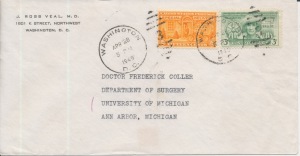The goal of the Postal Service has always been speed. The history of mail delivery, from the Roman postal roads to overnight service, has been one of ever increasing rapidity of written communication. Time is money, and the value of the post, especially in the post-1840 philatelic period, has been the ever increasing availability of rapid, inexpensive communications to ordinary people and businesses. Mail delivery was fast in nineteenth century America—certainly when compared to earlier eras. Letters within cities were often delivered the same day (there were three daily deliveries in downtown Philadelphia, for instance, in 1900), and mail was two days between major eastern cities and five days coast to coast—not bad for 2¢ postage in a time before airplanes. But even that wasn't fast enough, and by 1885 the Post office offered an even faster delivery system—Special delivery, which offered expedited service for around five times the cost of regular mail. Special Delivery usually could shave a day off of regular delivery which was important for contracts and time sensitive communications. Special Delivery was the precursor of Federal Express and overnight delivery services.
The Postal Service over time was a victim of its own success. By 1970, all mail that needed to be was being sent airmail for no additional cost, and coast to coast delivery was down to three days and often two days. And all of this was for the basic first class postage rate. Special Delivery was no longer needed in an environment like this and was gradually phased out. One of the great innovations in communications was the Federal Express corporation in the 1970s. Fed-Ex did Special Delivery one better; it offered delivery not only next day but by 10:30 AM. Business and law firms, who finished working on their documents and Fed-Exed (it even became a verb) them in the evening, had them where they needed to be by morning, ready to be worked on. As technology and computerization improved, email began to eat away at even more of the Post Office's first class business.
Seen in a longer context, Special Delivery stamps are the philatelic relic of the long desire for speed in communication. Starting on foot, then by horse (the Pony Express was really a Special Delivery service), rail (probably the greatest technological advance in postal delivery was the use of railroads—the lower costs of rail compared to horse allowed lower postal rates worldwide—US postage rates were cut by a third in the late nineteenth century- and sped up delivery considerably), and then air, mail service has taken advantage of every technological advance to improve delivery. Email is the ultimate Special Delivery—the goal of every postal service since the beginning: instantaneous and free.

